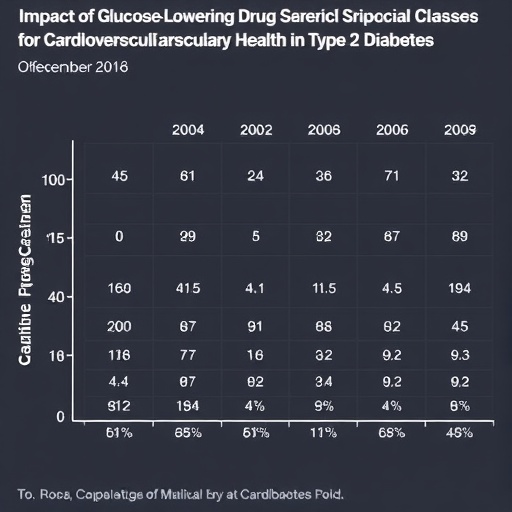A groundbreaking study recently published in JAMA Network Open unveils a nuanced hierarchy of cardiovascular risk reduction associated with various antidiabetic drug classes among adults with type 2 diabetes. The comprehensive analysis elucidates that sustained therapeutic regimens involving glucagon-like peptide-1 receptor agonists (GLP-1RAs) offer the most profound protection against major adverse cardiovascular events (MACE), surpassing other widely used medication classes. This discovery holds substantial implications for shaping clinical practices tailored to optimized cardiovascular outcomes in diabetic populations.
The researchers conducted an extensive evaluation of cardiovascular risk as stratified by different classes of glucose-lowering agents. GLP-1RAs emerged as the superior choice in reducing incidents such as myocardial infarction, stroke, and cardiovascular-related mortality. Following GLP-1RAs, sodium-glucose cotransporter-2 inhibitors (SGLT2is) demonstrated a commendable, albeit comparatively modest, protective effect. Notably, sulfonylureas and dipeptidyl peptidase-4 inhibitors also conferred measurable cardiovascular benefits, though these were less pronounced than those observed in GLP-1RA and SGLT2i therapies.
Delving deeper into the interplay between patient characteristics and treatment efficacy, the study reveals that the cardiovascular advantage of GLP-1RAs over SGLT2is is contingent upon critical baseline factors such as patient age, presence of established atherosclerotic cardiovascular disease, heart failure status, and degree of renal impairment. This stratification emphasizes the necessity for individualized therapeutic decision-making, recognizing that a universal approach may fail to leverage the maximum benefit available with precision medicine.
The mechanism behind GLP-1RAs’ superior cardiovascular protection extends beyond glucose-lowering capabilities. These agents enhance endothelial function, exert anti-inflammatory effects, and promote weight loss, collectively ameliorating vascular health. Their role in modulating atherosclerotic plaque stabilization and reducing arterial stiffness is particularly significant in mitigating cardiovascular events among diabetic patients who present with heightened vascular susceptibility.
SGLT2 inhibitors, by contrast, primarily reduce cardiovascular risk through mechanisms such as osmotic diuresis, reduction of plasma volume, and favorable effects on heart failure metrics. These physiological actions not only aid glycemic control but also meaningfully lower hospitalization for heart failure and progression of kidney disease, making SGLT2is vital therapeutic agents particularly for patients with concomitant cardiac or renal complications.
Sulfonylureas, long-standing components of type 2 diabetes management, demonstrated a degree of cardiovascular risk attenuation in this study; however, concerns regarding hypoglycemia and weight gain have historically tempered enthusiasm for their use. Despite these drawbacks, their relative affordability and accessibility ensure they remain a staple in certain clinical contexts, especially where cost constraints limit access to newer pharmacotherapies.
Dipeptidyl peptidase-4 inhibitors, known for their favorable safety profile and ease of administration, round out the list of antidiabetic agents with observed cardiovascular benefits, albeit less robust than GLP-1RAs and SGLT2is. Their mechanism primarily involves enhancing endogenous incretin hormone action, contributing to modest improvements in glycemic parameters and cardiovascular outcomes without the weight loss effects observed with GLP-1RAs.
The study’s multifactorial analysis illuminates the intricate balance clinicians must negotiate when selecting medications—integrating evidence-based efficacy, individual risk profiles, comorbid conditions, side effect potential, and economic considerations. Indeed, the cost and availability of these advanced therapeutic agents remain critical factors affecting their widespread adoption, especially in resource-limited settings.
Importantly, the authors advocate for cardiovascular risk reduction strategies that transcend glycemic control alone. The findings underscore the paradigm shift in diabetes management where cardiovascular safety and ancillary benefits constitute pivotal endpoints alongside traditional metrics such as hemoglobin A1c levels.
This research also calls attention to the importance of ongoing longitudinal assessments, as sustained treatment, not transient or non-adherence, emerged as a key determinant of cardiovascular benefit. This highlights a pressing need for patient education, adherence support programs, and systems-level interventions to ensure optimized long-term outcomes.
Moreover, the study sheds light on the emerging intersection between renal function and cardiovascular risk management in diabetes. The nuanced differences in drug efficacy depending on kidney impairment add complexity but also opportunity, enabling clinicians to tailor invaluable therapeutic strategies according to renal biomarkers and progression.
The inclusion of a diverse cohort with varying degrees of cardiovascular and renal comorbidities strengthens the generalizability of the findings and bolsters confidence in their applicability across a wide spectrum of clinical scenarios. The resultant evidence base sets the stage for refined clinical guidelines, reinforcing personalized medicine’s ascendancy in the ongoing battle against the dual epidemics of diabetes and cardiovascular disease.
In conclusion, this pivotal study from JAMA Network Open redefines the therapeutic landscape for adults with type 2 diabetes by stratifying cardiovascular risk reduction benefits among key medication classes. GLP-1 receptor agonists, with their multifaceted cardio-protective mechanisms, reign supreme in this hierarchy, while the positioning of SGLT2 inhibitors, sulfonylureas, and DPP-4 inhibitors provides a nuanced framework for optimizing individualized treatment plans. These insights, coupled with cost and accessibility considerations, pave the way for informed, patient-centered clinical decision-making aimed at eradicating the disproportionate cardiovascular burden borne by patients with type 2 diabetes.
Subject of Research: The cardiovascular risk reduction effects of different antidiabetic medication classes in adults with type 2 diabetes.
Article Title: Not provided.
News Publication Date: Not provided.
Web References: doi:10.1001/jamanetworkopen.2025.36100
References: Not provided.
Image Credits: Not provided.
Keywords: Type 2 diabetes, Glucose, Medications, Sodium channels, Medical treatments, Cardiovascular disorders, Risk factors, Age groups, Agonists, Adults, Cost effectiveness, Atherosclerotic plaque, Cardiovascular disease, Heart failure, Renal failure, Kidney, Decision making




